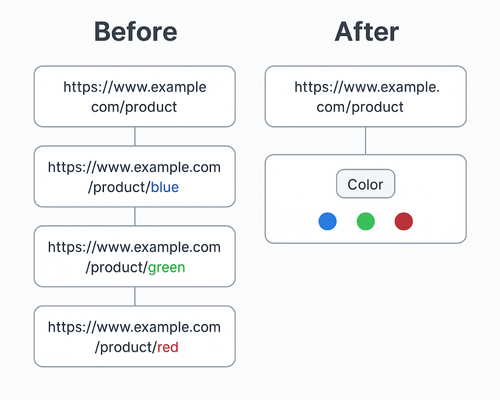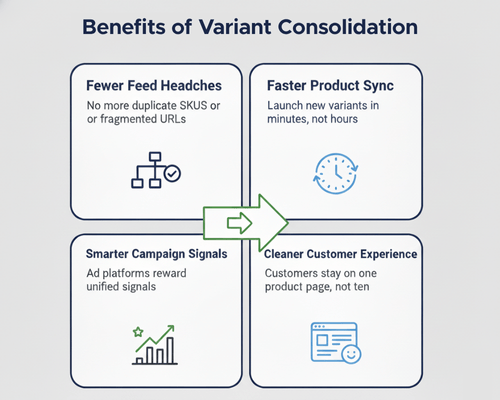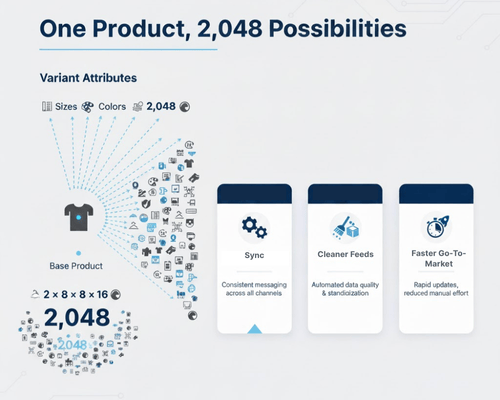Last week, Shopify recently released one of its most merchant-friendly updates in years: the product-variant limit has increased from 100 to 2,048 per product.
For brands selling apparel, jewelry, furniture, or configurable goods, this is a huge leap forward. No more splitting products into multiple listings just to stay under the old limit.
But beyond convenience, this change has real implications for product data strategy, feed management, and campaign performance.
At GoDataFeed, we help merchants unify and optimize product data across all the major shopping channels and marketplaces. Here’s our take on why this update matters — and how you can capitalize on it.
1. From Platform Constraint to Growth Opportunity
For years, Shopify’s 100-variant cap forced creative workarounds:
- Multiple listings for the same product.
- Custom scripts and bulky apps to handle options.
- Split URLs diluting SEO authority.
- Redundant SKUs cluttering feeds.

Now, Shopify’s jump to 2,048 variants removes a key structural limitation.
Merchants can finally centralize complex product lines — apparel brands with hundreds of size-color combos, furniture sellers with finishes and fabrics, even custom manufacturers with multiple configurations — into one master product page.
The result:
- Stronger canonical URLs → better SEO.
- Fewer feed complications → simpler catalogs.
- Unified variant experience → higher conversion rates.
And Shopify didn’t just raise the limit — they rebuilt backend infrastructure for performance. Product creation is now reportedly 10× faster, even with thousands of variants.
2. Strategic Implications for Merchants
Feed Simplification
When each color or size no longer needs a separate listing, your feed instantly becomes cleaner. You can map one product with variant-level attributes (size, color, material) rather than 10 split SKUs.
That means fewer rules, fewer feeds, and less maintenance — all core to GoDataFeed’s “unified feed” approach.

Marketing Efficiency
Fewer URLs = consolidated ad signals. Your paid, organic, and social campaigns all point to one canonical product page instead of many. That boosts quality scores, link authority, and attribution clarity.
Faster Time-to-Market
Previously, adding new colorways or limited-edition drops meant duplicating listings and updating multiple feeds. Now, new variants can go live instantly within the same product — reducing launch friction and speeding campaign rollout.
Performance & UX
Shopify’s update improves backend performance, but merchants must still ensure front-end efficiency. Thousands of variants can stress theme logic, so test variant selectors, image loading, and mobile UX carefully.
[At the feed level, well-structured product attributes also reduce performance bottlenecks in shopping campaigns]
3. Tactical Playbook: Making the Most of 2,048 Variants
Here’s how to turn this update into measurable gains:
Step 1: Audit Your Catalog
Identify products that were artificially split to stay under 100 variants. Plan to merge them, ensuring all variants share a common URL and metadata.
[See how GoDataFeed handles product variations for supported structures]
Step 2: Consolidate Listings
Combine related products where feasible.Redirect old listings (301s) to retain SEO value, and update product data to reflect the unified structure.
Step 3: Refactor Your Feed Mapping
Switch from multiple SKUs per variant to one parent SKU with variant attributes. In GoDataFeed, this means mapping “variant fields” (size, color, material) to channel-specific attributes, such as g:size and g:color for Google or their equivalents for Meta and Amazon.
[Here’s how to map variant fields in GoDataFeed by channel.]

Step 4: Optimize Variant-Level Attributes
Use clear, descriptive values — “Midnight Velvet” instead of “BLK-05.” High-quality variant data improves ad relevance and product discovery.
[Use this attribute mapping tutorial to ensure clean data across variants]
Step 5: Monitor Campaign Performance
After consolidation, track metrics:
- Are bounce rates down?
- Are campaign ROAS and CTR up?
- Is feed approval smoother?

Use GoDataFeed’s channel dashboards to spot gains and surface issues quickly.
Step 6: Plan for Scale
Build variant taxonomy now (size, color, material, pattern, finish) that can scale as your catalog grows.The 2,048-variant limit is headroom — use it wisely for seasonal drops or custom products.
4. The GoDataFeed Advantage
Shopify’s update solves a platform problem. GoDataFeed solves the operational one.

When you unify your product catalog under Shopify’s new variant structure and connect it through GoDataFeed:
- Your feed becomes cleaner, faster, and smarter.
- Your campaigns sync instantly to Google, Meta, Amazon, and Walmart.
- Your marketing team spends less time debugging SKUs and more time scaling sales.
In short, the Shopify variant expansion multiplies the impact of a well-architected feed strategy — and that’s where we excel.
One Product. 2,048 Possibilities.
Shopify’s variant limit expansion marks a turning point for brands with complex catalogs. But to fully capitalize, merchants must align catalog architecture, feed management, and campaign execution.
If you’re a Shopify merchant ready to simplify feeds, unify variants, and boost campaign efficiency — GoDataFeed can help.
Request a Feed Audit today to see how your Shopify catalog can perform under the new 2,048-variant limit.




%20).png)

%20).png)